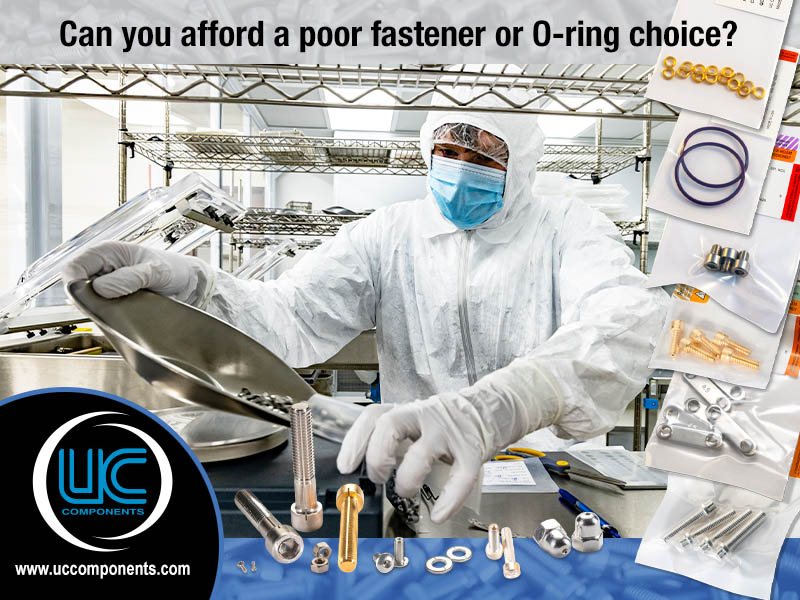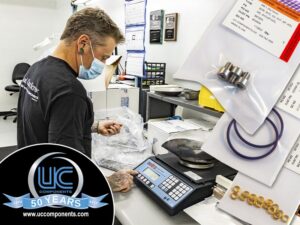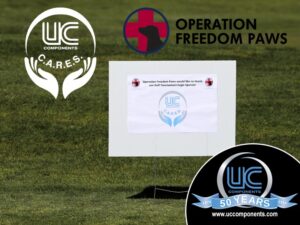A flawed fastener or O-ring could ruin the effectiveness of your product, compromise your entire project or cause a variety of serious issues that can lead to failure.
Here we will quickly go over six sources or causes of potentially catastrophic issues:
- Particulate Contamination
- Hydrocarbon Contamination
- Virtual Leaks
- Outgassing
- Galling
- Mechanical Integrity and Accuracy
1.) Particulate Contamination
Most semiconductor and other vacuum processing applications, as well as a variety of other clean-critical applications, require parts that are free from surface particulate. The origins of surface particulate are numerous, including:
- Post-machining burrs and metal shavings, mold flashing, or uneven splicing seems
- Dust and dirt from un-controlled environments
- Packaging residue
How do you fix particulate contamination problems?
Properly cleaned and baked O-rings and vented fasteners, such as the RediVac® line from UC Components, Inc., is your best option. The RediVac® branding signifies an added level of particulate cleanliness assurance via in-process inspection, post machining deburring, and rinsing, followed by multi-stage ultrasonic cleaning in a controlled environment.
2.) Hydrocarbon Contamination
Hydrocarbon-based lubricants (such as oils and grease) can be a major source of contamination and are difficult to remove. They have very low vapor pressure and will spread throughout a tool quickly, requiring both lengthy and costly cleaning to fully remove, not to mention potential product (wafer or substrate) defect or outright failure. Hydrocarbon contamination could be from original parts, subsequent manufacturing processes, or even a fingerprint.
How do you fix hydrocarbon contamination?
The best way to fix lubricant contamination is to prevent it from happening in the first place. Never introduce lubricants into systems where they should not be, such as using oil-based lubricants during assembly. Utilizing properly cleaned and baked O-rings and vacuum/clean-critical appropriate finished products, such as the RediVac® line from UC Components, Inc., is your best option.
3.) Virtual Leaks
A virtual leak is a trapped volume of gas at the base of blind-tapped holes within a vacuum chamber that cannot easily be pumped away. These are “internal” leaks preventing or delaying operational system pressure. Fasteners are typically the source of virtual leaks in sealed systems as there may be voids between the parts being restrained, the threads and shoulder of the screws, or other incompletely filled holes.
How do you solve a virtual leak issue?
The best way to solve a virtual leak is to utilize vented fasteners. UC Components, Inc. manufactures a wide range of RediVac® vented screws, washers, and hex nuts that provide a path for trapped air to be pumped away from the bottoms, sides, and shoulders of blind-tapped holes. This allows for faster, more thorough pump-down of vacuum systems and eliminates virtual leaks and any potential contaminants that can be found in these voids.
4.) Outgassing (H2O and other)
Outgassing, also called off-gassing, refers to the release of gas that has become trapped, frozen, dissolved, or absorbed in another material. Outgassing is a common problem when creating, or maintaining, a high-vacuum or other clean-critical environment. Hydrocarbon contamination (mentioned above) is a major source of outgassing. However, the most common form of outgassing is water on surfaces, in the atmosphere, and trapped within porous ceramics and metals. O-Rings also have vast amounts of trapped water, often amounting to over 2% of their total weight.
How can outgassing be solved?
Utilizing the proper fastener base material, cleaning surfaces properly, and/or heating individual components (a process called “bake-out”) can help eliminate outgassing and other issues in your system. UC Components RediVac® vacuum baking process involves placing the parts into a chamber and heating them, under vacuum, to drive out gases and other contaminants trapped in the parts.
5.) Galling
Galling, often called cold-welding or cold-fusing, can occur when two fastener surfaces are placed under heavy pressure and lock together. Galling tends to be more common in alloys that self-generate an oxide surface film for corrosion protection, like stainless steel, aluminum, and titanium. In High Vacuum and Ultra High Vacuum systems, like materials can become cold-fused together due to thermal expansion and the lack of moisture created by the vacuum. This phenomenon is not exclusive to vacuum and can happen in many process environments, particularly those in which lubrication is limited or not permitted.
How do you prevent galling?
The best way to avoid galling is to use a lubricant or anti-seize. However, in UHV or other clean applications using anti-seize lubricants is not an option because of the possibility of contamination. In these instances, you will need to use a fastener finish that is designed to prevent galling (such as those offered by UC Components, Inc. RediVac® lines), utilize parts that are made from alloys that lower the possibility of galling, or another solution.
6.) Mechanical Integrity and Accuracy
UC Components, Inc. is an ISO9001 company, and we take our incoming inspection extremely seriously. Our product value is majority value-add starting from poor raw material only leads to great expense and consternation downstream. As a result, the UC incoming inspection area and process are well-equipped, lit, and staffed with CFS (Certified Fastener Specialist) graduates. Thorough inspection records are kept and available for review, and all product is lot controlled for start-to-end traceability.
How do you fix a mechanical integrity and accuracy problem?
You don’t; UC does.
The proper material makeup, treatment, and handling of fasteners and O-rings for your vacuum and clean-critical applications cannot be taken lightly. The value of proper O-rings and fasteners may seem trivial, but their overall performance and savings for you (both in cost and time) can be measured. By partnering with UC Components, Inc. manufacturers like you not only solve the incumbent issues discussed here but also boost safety, quality, speed to market, and profitability.
Want more? Take a look at this quick video which gives a bit more detail about the above information:
UC Components, Inc. can help!
UC Components, Inc. RediVac® O-rings are specially processed for use in critical applications. Our O-rings are cleaned and packaged in our certified Class 100/ISO Class 5 Cleanroom, making them suitable for immediate use in most HV, UHV, EUV, or other clean-critical applications. Vacuum baked O-rings are available for reduced outgassing under vacuum.
Our standard O-rings are manufactured from top-quality fluoroelastomer materials. Buna, silicone, and other materials are available upon request. Specific chemistries may also be available upon request.
UC Components, Inc. has been the world leader in high vacuum hardware since 1974. We specialize in O-rings and fasteners for High Vacuum, Ultra High Vacuum, and other critical applications. View our parts catalog online to find the components you need, request a quote, or contact us for more assistance or additional information.



